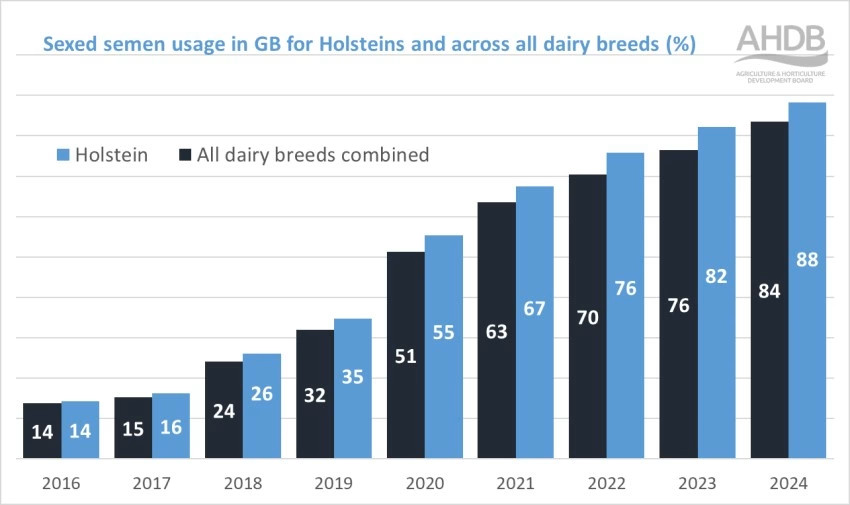Explore the transformative impact of sexed semen on Great Britain’s dairy industry, driving remarkable genetic advancements and enhancing beef output. Learn how this strategic shift is revolutionizing farming practices and benefitting dairy farmers.

Great Britain is setting the standard in dairy production by employing sexed dairy semen and thereby creating new international guidelines. Not just a trend, but also a major development with significant consequences for the industry. Farmers may now selectively breed their best females with modern breeding methods, quickening genetic development.
“UK dairy farmers should be congratulated on their progressive attitude to adopting modern technologies to improve their herd efficiencies; they are leading the world in accepting sexed semen.” Head of Animal Genetics, AHDB Marco Winters
Discover how this innovative strategy is reshaping the dairy and beef supply chains, thereby fostering a brighter future for both consumers and farmers.
Transformative Breeding: The Rise of Sexed Dairy Semen and Its Impact on the Dairy Sector
AHDB, a key player in the industry, has been instrumental in promoting the acceptability of sexed dairy semen. Their most recent survey indicates a notable increase in its usage, underlining the dairy sector’s progressive attitude to reproductive technologies. Sales of sexed semen rose from 76% in 2023 to 84% in 2024. This trend reveals the sector’s ambition to increase herd efficiency and hasten genetic progress. The increased use of sexed semen is changing breeding strategies by selecting top females and modifying the genetic geography of British dairy farms.
The Unrivaled Reign of Holsteins: Leading the Charge in Genetic Advancement
Leading the dairy industry with 88% of all Holstein semen sold today sexed, the breed is ahead of the average of 84%. This highlights its main contribution to advancing efficient and genetically altered farming techniques.
Driving Forces Behind the Surge in Beef Semen Sales
Increasing beef semen sales result from many significant developments altering the dairy industry. Farmers have been able to focus their breeding on outstanding females for dairy replacements using sexed dairy semen. This exact husbandry produces a surplus of genetic potential in the rest of the herd, enabling further use of beef semen.
Now, considering 52% of all semen sent to dairy farms, sales of beef semen surpass those of dairy goods for the first time. This shift alludes to a trend wherein dairy farmers generate highly sought-after beef crosses, increasing the economic value of non-replacement animals. This economic advantage, coupled with the genetic benefits, makes the use of sexed semen a compelling choice for dairy farmers.
Technologies like SexedULTRA4M accelerate these advances by consistently producing female dairy calves and steering other breeding projects toward beef crosses. This approach enhances dairy herd genetics and significantly boosts the beef supply chain, stressing the innovative synergy between dairy and beef production. This forward-looking breeding method increases profitability and output for farmers across the agricultural land.
The Strategic Application of Selective Breeding Through Sexed Semen Technology
Dairy farmers stand to gain significantly from the strategic use of sexed semen technology. By enabling the deliberate selection of superior females for reproduction, farmers can ensure that only the best genetic traits are passed on to future dairy replacements. This focused breeding accelerates genetic development, bolstering milk supply, lifetime, and overall herd health.
Moreover, sexed semen significantly increases the likelihood of female calves, which are naturally more lucrative for dairy companies. Farmers may focus their efforts on raising females predisposed to superior performance requirements through this optimization. This approach not only guarantees long-term sustainability and profitability but also genetic development through a more efficient and productive herd with every generation. The use of sexed semen is not just a short-term solution but a strategic investment in the future of the dairy industry.
The proper use of sexed semen in breeding efforts allows dairy farmers to promptly and effectively maximize genetic advantages. This forward-looking attitude highlights how dedicated the dairy industry is to using innovative technologies for exceptional herd performance and creative expression.
The Bottom Line
Great Britain’s strength in agricultural innovation is shown in its use of sexed dairy semen. Especially among Holsteins, a jump to 84% in sexed semen usage reveals a deliberate focus on genetic quality. More beef crosses enhance dairy genetics and the beef market, ensuring farmers remain competitive and efficient.
Dairy producers should use genomic studies and the Herd Genetic Report published by the AHDB to maximize breeding initiatives. The adoption of these cutting-edge technologies will constantly propel genetic development, increase herd efficiency, and maintain the dairy industry’s worldwide leadership.
Key Takeaways:
- Sales of sexed dairy semen reached 84% of all dairy semen sold over the 12 months leading up to April 2024, up from 76% in 2023.
- The Holstein breed stands out, with sexed semen accounting for 88% of all their semen sales.
- The use of sexed dairy semen has facilitated an increase in the adoption of beef semen, which now constitutes 52% of all semen sold to dairy farms.
- This trend empowers dairy farmers to selectively breed their elite females for dairy replacements, enhancing genetic progress within the herd.
- Dairy farmers are encouraged to leverage genomic evaluations and the AHDB’s Herd Genetic Report to identify top females for breeding decisions.
- The growing production of beef crosses in the dairy sector has positive implications for the beef supply chain and the overall efficiency of dairy herd genetics.











